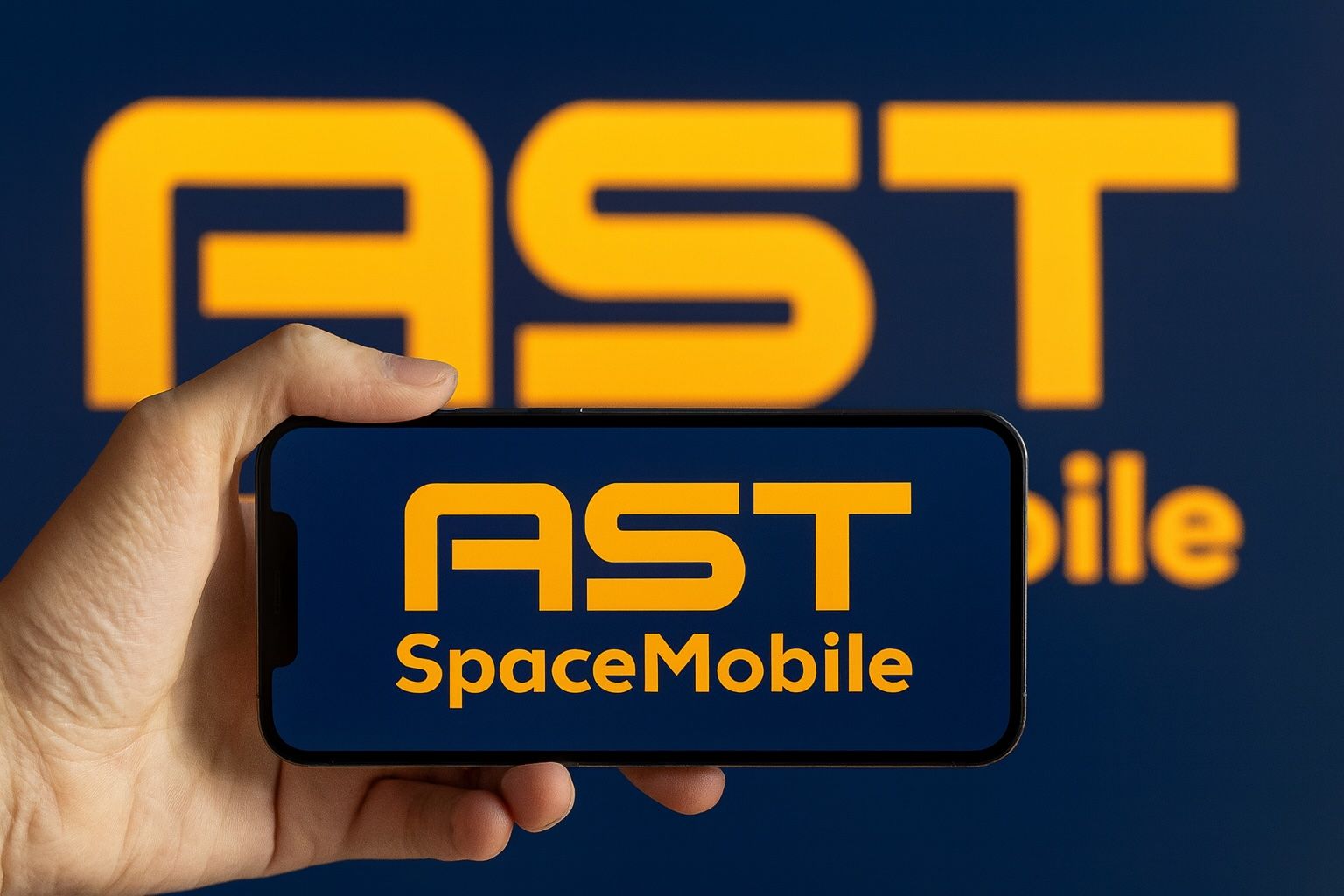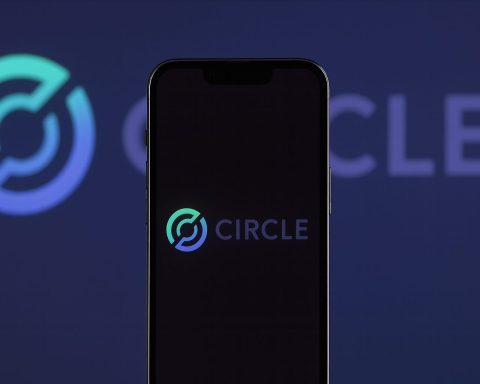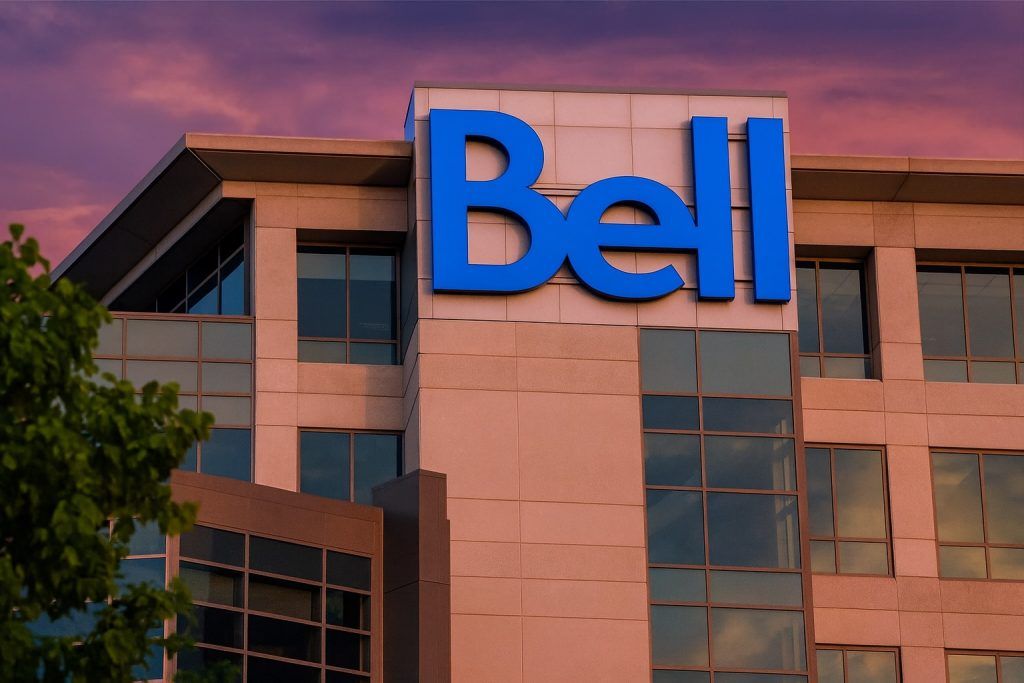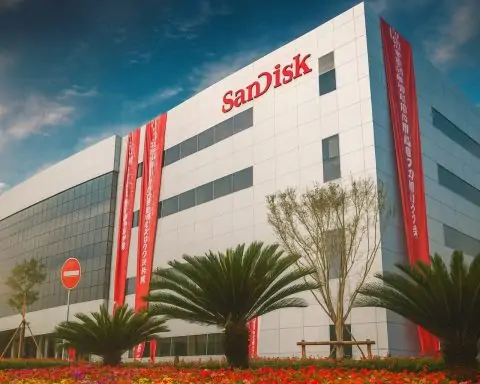- ASTS Hits New Highs: AST SpaceMobile (NASDAQ: ASTS) surged to all-time highs in mid-October 2025, nearing the $100 mark intraday. As of October 14, 2025, ASTS traded around $98 per share, up roughly 200% year-to-date, making it one of this year’s top-performing stocks.
- Verizon’s Space Partnership: A landmark deal with Verizon announced October 8 sent ASTS stock jumping ~7% that day. Verizon will use AST’s satellites to beam service to ordinary phones starting in 2026 – a potential game-changer for eliminating cellular dead zones [1].
- Satellite Milestones: AST SpaceMobile achieved the first ever direct-to-cell phone voice and video calls from space, using its BlueWalker 3 test satellite. It just finished building its next-gen BlueBird 6 satellite and plans to deploy 45–60 satellites by 2026 for global coverage.
- 50+ Carriers Onboard: Over 50 mobile operators worldwide – including AT&T, Vodafone, Bell Canada, Rakuten, and others – have signed on to offer AST’s space-based mobile broadband to their subscribers. In recent weeks, Bell Canada completed that country’s first satellite 4G call via AST’s network, validating the technology’s real-world utility.
- Bull vs. Bear Debate:Analysts are divided on ASTS’s sky-high valuation. Bulls tout AST’s “game-changing” tech and massive addressable market, with one analysis suggesting the stock could be worth over $200 if all goes to plan. Bears warn of steep execution risks and an “extremely rich” valuation – the stock trades at over 30× book value with essentially no revenue [2]. The consensus 1-year target is only in the mid-$40s [3], well below the current price.
ASTS Stock Soars to Record Highs
AST SpaceMobile’s stock has been on a tear, more than tripling in 2025 amid excitement around its satellite-to-cellphone technology. The rally hit overdrive in early October: on October 1–2, ASTS leapt about 16% per day, breaking out from the $40s to close above $66. By October 7, shares hit the mid-$70s – a fresh 52-week high around $74.77. The momentum continued into this week as ASTS nearly touched $99 on October 14 (a new intraday record of $98.59). As of midday Oct. 14, the stock hovered just under $97 (up ~8% on the day), valuing the company near $30 billion market cap. For context, ASTS traded around $30 late last year, so it has gained roughly 200% year-to-date.
Such torrid gains have attracted swarms of retail traders – ASTS became a trending ticker on stock forums as it climbed, with “extremely bullish” sentiment driving high volume buying [4]. At the same time, short sellers have piled in: roughly 18% of ASTS’s float is sold short, a sign of skepticism about the company’s lofty valuation. This dynamic sets the stage for volatility, as evidenced by massive trading volumes (on Oct. 8, volume spiked to ~43 million shares, about 3× the three-month average) and big intraday swings. Overall, ASTS’s stock has been highly volatile, with daily moves often exceeding 10%. In fact, over the past week the stock’s average daily trading range was around 11.8%, and technical analysts classify ASTS as a “very high risk” play at current levels [5].
Satellite Breakthroughs Fueling the Hype
Why are investors so excited? AST SpaceMobile is attempting something straight out of science fiction: building the first space-based cellular broadband network that can connect directly to standard mobile phones on Earth [6]. In essence, AST is launching “cell towers in space.” Its large low-Earth-orbit satellites (called BlueBirds) deploy enormous phased-array antennas ~2,400 square feet in size, allowing them to communicate with normal 4G/5G smartphones using ordinary cellular frequencies (850 MHz, L-band, etc.) [7] [8]. No special satellite phones or adapters are required – a regular handset will automatically roam onto an AST satellite when out of tower range, making connectivity truly ubiquitous. As AST’s president neatly put it, “the phone just works” anywhere once the satellite network is active. This vision of seamless global coverage has been a major selling point for the company.
Crucially, AST has been backing up the concept with tangible technical milestones. In 2023, its prototype BlueWalker 3 satellite unfurled in orbit and successfully linked to standard smartphones, proving the core technology works. By mid-2025 AST achieved a world-first: the first-ever voice calls and even live video calls via satellite between unmodified cell phones. For example, AST partnered with carriers Vodafone and Rakuten to conduct a 4G voice/video call from space (connecting a smartphone in the UK to one in Japan) using the test satellite. Just days before the Verizon deal, Bell Canada similarly completed that country’s first space-based 4G call and SMS using AST’s network. These successful demos – going beyond one-way emergency texting to full two-way broadband data and voice – have been hailed as “historic milestones” in communications. They validated that AST’s technology can deliver what it promises: real phone service (voice, data, video) from orbit.
AST’s next challenge is to go from demos to full deployment. The company has already launched five commercial BlueBird satellites (its initial Block-1 batch in late 2024) and just completed assembly of its next-generation BlueBird-6. According to AST, BlueBird-6 is the first of a more powerful Block-2 generation, and it’s slated for launch in the near term. The firm aims to rapidly scale to 45–60 satellites in orbit by end of 2026 to begin continuous coverage in key regions. In fact, AST’s CEO Abel Avellan said they have a “fully-funded plan” for near-monthly launches through 2025–26 to reach that constellation target [9]. Initial intermittent service could start by late 2025 as more satellites come online, with commercial direct-to-phone coverage rolling out in 2026 across partners like AT&T (U.S.), Bell (Canada), Telefonica (Europe), Rakuten (Japan) and others. The ultimate vision is ~90 satellites for global coverage a couple years later. In short, AST is moving aggressively to turn its one-of-a-kind satellite network into a reality.
Verizon Deal Sends ASTS Into Orbit
The watershed moment driving the latest leg of ASTS’s rally was a new Verizon partnership unveiled on October 8. Verizon, one of the largest U.S. mobile carriers, inked a definitive commercial agreement with AST SpaceMobile to beam cellular service from space across the continental U.S. starting in 2026. Under this pact, Verizon will integrate AST’s satellite constellation with its terrestrial network, allowing Verizon customers to automatically connect via satellite when they move outside cell tower range [10]. In practical terms, once AST’s system is live, a Verizon user in a remote wilderness or offshore could still get a signal and use their phone normally by piggybacking on a satellite overhead. This promises to eliminate “dead zones” and expand coverage to essentially everywhere in the U.S. without the need for any special equipment.
Verizon had been collaborating with AST on trials since 2024, but this new deal cements the alliance with a revenue-sharing service rollout plan. Executives on both sides struck an optimistic tone. “Through our agreement with Verizon, we are working to deliver space-based cellular broadband coverage … across the United States,” said AST CEO Abel Avellan, calling it an extension of Verizon’s premium low-band spectrum into hard-to-reach areas [11]. Verizon’s technology chief Srini Kalapala lauded the partnership as “creating a new paradigm of connectivity” – one where customers stay connected “regardless of geography” by seamlessly hopping between terrestrial and satellite networks. In essence, Verizon sees AST’s satellites as an innovative way to fill coverage gaps for its subscribers, especially in rural or off-grid locations that are impractical to cover with land-based towers.
For AST SpaceMobile, landing a marquee customer like Verizon was a validation moment – and the market reacted accordingly. ASTS shares spiked ~15% in early October as rumors of major carrier deals swirled, then jumped another 7% on Oct. 8 when the Verizon news became official. The stock hit all-time highs in the mid-$70s on the announcement. Analysts noted that Verizon’s stamp of approval increases confidence in AST’s business model (which relies on partnering with existing mobile network operators rather than acquiring end users directly). It also could open the door to revenue once service begins – Verizon will presumably pay AST for satellite bandwidth to extend its coverage. While exact financial terms weren’t disclosed, the deal is strategically huge for AST: it demonstrates that top-tier carriers see value in its technology. Verizon’s involvement may also spur other telecoms to solidify their own agreements with AST. Already the company lists 50+ carriers globally in its partner roster, covering an estimated 3 billion potential subscribers across dozens of countries. AT&T (which invested in AST and partnered on an earlier R&D pact with Google), Vodafone, Rakuten, Bell, Telefonica, Orange, América Móvil and many others are on board to eventually offer space-based coverage via AST’s network. The Verizon deal, however, is among the first to go from memorandum to a definitive service launch commitment, starting with the U.S. in 2026. This momentum on the commercial front has undoubtedly been a key catalyst for ASTS’s recent bull run.
Funding the Space Ambition (Cash Burn and Dilution)
Building a constellation of space “cell towers” is not cheap – and AST SpaceMobile remains pre-revenue (no meaningful commercial sales yet). The company has been burning cash to develop its technology and satellites, running operating expenses of around $70–75 million per quarter. To fund its ambitious rollout, AST has tapped the capital markets several times, including some moves that gave investors pause. In July 2025, the company raised $575 million via convertible notes (debt that can convert to equity). Then in October it filed plans for an “at-the-market” (ATM) stock offering to sell up to $800 million in new shares over time. Essentially, AST registered to dilute its equity as needed to raise additional cash. News of this large secondary offering – announced on October 7 – caused ASTS stock to dip about 6% that day on dilution fears. Even amid euphoria for AST’s story, shareholders showed concern that issuing up to $800M of stock could weigh on the price.
The company, for its part, maintains that it now has enough funding lined up to execute its near-term plans. As of mid-2025, AST held roughly $1.5 billion in cash on its balance sheet (pro forma for recent financings). Management estimates it will require about $1.5 billion through 2026 to launch the first few dozen satellites and start commercial service. If that number holds, AST may be able to reach initial operating capacity without returning to the equity well again beyond the current ATM program. “We have a fully-funded plan,” CEO Avellan has asserted [12], to deploy 45-60 satellites by 2026. Nonetheless, industry observers note that space ventures often face cost overruns, and AST has left the door open to raising more capital if needed. The hefty funding needs introduce a risk of further dilution or debt if expenses climb.
On a positive note, AST SpaceMobile has garnered big-name backers that provide credibility (and some cash). Its investor roster reads like a who’s who of telecom: Vodafone, AT&T, Verizon, Rakuten, American Tower, and even Google (Alphabet) have all invested in or partnered with AST. This strategic backing not only gives AST financial runway but also indicates that potential customers want it to succeed. The company has also secured valuable wireless spectrum for its network – acquiring global rights to use S-band frequencies for about $64.5M, and obtaining FCC approval to launch 20 satellites (with more applications pending). These moves shore up the regulatory and technical foundation for AST’s system, but until the service actually generates revenue, the financial picture will consist of large outflows and meager inflows. In Q2 2025, AST reported a net loss of about $0.41 per share on only $1.2 million of pilot revenue, missing earnings expectations. The company did issue upbeat guidance for the second half of 2025 (projecting $50–75M in pilot and initial service revenue), but meaningful profits likely remain years away. Investors thus have to weigh the near-term cash burn against the longer-term payoff if AST’s global service takes off.
Bulls vs. Bears: Can ASTS Justify the Hype?
With ASTS stock’s stratospheric rise, analysts and experts are sharply divided on how much higher (if at all) it can go. The bullish camp argues that AST SpaceMobile’s technology addresses a massive unmet need – billions of mobile users still experience coverage gaps or no connectivity, especially in developing regions. If AST can capture even a fraction of this market by selling satellite coverage through carriers, they believe the revenue potential is enormous. Optimists also point to AST’s unique capability to deliver real broadband and voice to normal phones, whereas competitors (like satellite-phone incumbents or SpaceX’s planned service) are so far limited to low-data-rate texting or emergency use. This could let AST charge a premium for a superior service. “AST SpaceMobile’s technology is a game-changer,” one Wall Street bull said, potentially unlocking an untapped market and eventually generating billions in annual cash flow if executed properly. Some have tried to quantify this future value: a recent discounted cash flow analysis suggested ASTS shares might be intrinsically worth over $200 – implying the stock could still be undervalued if the company meets aggressive growth projections. Major telecom partnerships and successful tests lend credence to the idea that AST could revolutionize mobile connectivity, the bulls contend.
However, the bearish side sees a reality check looming. Skeptics note that AST SpaceMobile, for all its promise, is essentially a pre-revenue startup with a towering valuation. At nearly $100 a share, ASTS’s market capitalization is around $30 billion – yet the company has not proven it can turn a profit (or even generate substantial revenue). By traditional metrics, the stock looks extremely expensive: it trades at over 6000× trailing sales and around 32× book value, ratios virtually unheard of outside of speculative tech mania. Even within the aerospace/telecom sector, ASTS’s valuation is an outlier (the average price-to-book for telecom firms is roughly 1.5×) [13]. This means investors are pricing in years of spectacular growth well ahead of actual results. Any misstep or delay could trigger a sharp correction as the bubble deflates. “Enormous execution risk” hangs over the company, bears warn [14] – launching dozens of satellites on schedule, obtaining regulatory approvals, and convincing millions of end-users to actually use (and pay for) the service are no small feats. Competition is another worry: while AST has an early lead on direct phone connectivity, deep-pocketed rivals like SpaceX (partnering with T-Mobile) and Amazon’s Project Kuiper are also eyeing the satellite communications market [15]. If those or other players find a way to offer similar capabilities, AST could face a crowded field by the time it’s fully operational.
Wall Street’s official outlook reflects these mixed sentiments. Among analysts, ASTS carries a Hold rating on average, and the consensus 12-month price target is about $45 – barely half the current trading level [16]. For instance, UBS downgraded the stock in September 2025, citing the long road to profitability, and set a $43 price target [17]. At least one brokerage reportedly issued a rare “sell” rating after ASTS ran up over 250% in a few months [18]. On the flip side, Barclays in early October raised its target to $60 (from $37 prior) and maintained an Overweight, arguing AST’s recent milestones justify a more optimistic view. Barclays analysts highlighted AST’s ability to provide full voice/data service versus rivals’ text-only links as a key advantage that could translate to premium pricing power. The bottom line is that professional analysts are far from unanimous – some see multibagger upside remaining, while others see a stock priced for perfection. This bull/bear tug-of-war is likely contributing to the stock’s volatility as each new development is intensely scrutinized.
The Satellite-to-Phone Race Heats Up
AST SpaceMobile is not alone in shooting for the stars. The broader satellite communications sector has become a hotbed of activity, with both start-ups and tech giants aiming to connect devices off the terrestrial grid. Elon Musk’s SpaceX, for example, is working with T-Mobile on a plan to use Starlink satellites for texting services to normal phones, though initially limited to SMS/MMS in emergencies. In the smartphone realm, Apple introduced satellite-based SOS messaging for iPhones (leveraging Globalstar’s network) in 2022, and that service is now a standard safety feature – albeit only for basic text alerts. Smaller player Lynk Global has also launched a few satellites and demonstrated rudimentary direct-to-phone SMS for carriers in Africa and elsewhere [19]. Traditional satellite operators like Iridium and Inmarsat have begun partnering with mobile providers as well, integrating satellite links for niche capabilities (e.g. Garmin devices, or IoT connectivity) [20]. Even Amazon is entering the fray with Project Kuiper, a planned LEO constellation to deliver broadband (more analogous to SpaceX’s Starlink, focusing on user terminals for internet rather than standard phones) [21].
What sets AST SpaceMobile apart, at least for now, is that it aims to offer full-fledged broadband, voice and data service to unmodified phones, effectively extending the reach of mobile networks to anywhere on the planet. Competitors’ offerings are currently far more limited – for instance, SpaceX/T-Mobile’s initiative would initially only support texting and perhaps slow data for emergency use, not voice calls or high-speed data. Apple’s solution is one-way and emergency-focused. AST’s satellites, by contrast, have demonstrated two-way voice calls and video streaming from space, making them a potential one-stop solution for connectivity in remote areas. This breadth of capability is a key differentiator and one reason carriers like AT&T, Vodafone and Verizon have thrown support behind AST. That said, AST’s wide-open opportunity could narrow if others catch up technologically. SpaceX has thousands of Starlink satellites already in orbit (albeit serving broadband to dish terminals currently), and companies like Iridium are partnering with chipset makers to enable direct sat-phone features in new smartphones. Additionally, Boeing, Amazon, and startups like Omnispace are exploring satellite-direct-to-device concepts. The competitive landscape is thus likely to intensify, and AST will have to execute flawlessly to maintain its first-mover advantage. Industry analysts have noted that AST’s plan leaves “no margin for error” given the fierce competition and high stakes. It must launch on schedule, avoid technical failures, and sign up enough paying users through its partner carriers to fend off rivals once they enter the market.
Macro factors could also influence AST SpaceMobile’s journey. The company’s surge comes amid a broader boom in space-related stocks and a generally strong tech market in 2025 – the Nasdaq recently hit record highs [22], and investor appetite for futuristic tech remains robust. However, rising interest rates and tighter financing conditions compared to a few years ago mean that capital-intensive ventures like AST have less room for error. If market conditions turn or risk aversion rises, a high-flying, speculative stock like ASTS could see more pronounced swings (or difficulty raising additional funds). For now, though, the satellite-to-phone theme is capturing imaginations, and AST SpaceMobile has positioned itself as a front-runner in what could become a multi-billion-dollar segment of the telecom industry.
Technical Outlook: High Volatility and Overbought Signals
ASTS’s rocket-like ascent has come with equally intense volatility. Traders note that the stock often moves in double-digit percentage swings within a single session. In the first week of October alone, ASTS ripped nearly +50% in five trading days, then pulled back about 5–6% on profit-taking and dilution news before surging again. Such whipsaw action is not for the faint of heart. Over the last 10 trading days, ASTS rose on 9 of them and is up over 85% in the past two weeks [23]. Momentum indicators are flashing extremes. The stock’s 14-day Relative Strength Index (RSI) recently pushed above 80, well into “overbought” territory (anything over 70 is considered overbought) [24]. Generally an RSI that high suggests a stock may be due for a cooling-off or correction. Technical analysts have also observed that ASTS blasted above its short-term upward price channel, indicating an even steeper climb than the prior trend – a sign of blow-off momentum. One analysis pegged around $98 as a possible resistance level on the current surge [25], which indeed was roughly where the stock peaked intraday on Oct. 14 before hesitating. If a pullback occurs, previous breakout levels in the high-$60s or support around ~$86 (the recent consolidation zone) could serve as support on the downside [26].
Traders are managing risk carefully given ASTS’s propensity for sudden moves. The stock’s beta is very high, and its daily volatility ranks it among the most erratic stocks on the NASDAQ [27]. In practical terms, this means large gains can evaporate quickly – and vice versa. The presence of a large short interest (~18% of the float) adds fuel to the fire. Rapid price spikes can force short sellers to cover (buy back shares), which amplifies rallies. Conversely, any negative news or fading momentum could see shorts press their bets, adding selling pressure. This tug-of-war can lead to exaggerated price swings in both directions. It’s also worth noting ASTS has a relatively large retail shareholder base active on social media, which can contribute to herd-like trading behavior and breakouts not always tied to fundamentals. All these factors make ASTS something of a trading vehicle as much as an investment in a long-term vision.
From a technical analysis standpoint, some caution flags are waving. The stock’s rapid ascent with declining volume in some recent sessions hints at a possible weakening of the rally’s breadth [28] [29]. (Volume on Oct. 13 was a bit lower than earlier in the month, even as price hit new highs, a pattern that can precede short-term reversals.) Chartists also point out that ASTS is now far above its moving averages – for example, it’s trading well above even its 20-day and 50-day averages, which themselves are sloping sharply upward. Any reversal could be swift if momentum traders head for the exits. On the other hand, as long as ASTS stays in an uptrend, trend-following signals remain positive – both short and long-term moving averages are pointing up, and a “golden cross” occurred in recent months when the 50-day MA crossed above the 200-day [30]. In summary, the technicals depict a stock on a powerful uptrend but one that is overextended and prone to abrupt corrections. Caution is warranted, and traders are advised to use risk management (stop-loss orders, hedging, etc.) given the high-risk, high-reward nature of ASTS at this stage [31] [32].
Outlook: Sky-High Potential vs. Down-to-Earth Challenges
AST SpaceMobile has captured the market’s imagination with its promise of ending mobile dead zones and bringing broadband connectivity to every corner of the globe. The recent Verizon deal and successful satellite tests lend credibility to what was once a far-fetched concept. Looking ahead, the next milestones for AST will be deploying its next batch of satellites and scaling up service trials with carrier partners. Investors will be watching for any updates on launch schedules, initial user feedback from pilot programs, and perhaps early revenue in late 2025 or 2026 as carriers start offering satellite coverage as a premium add-on.
However, AST SpaceMobile now faces the task of living up to sky-high expectations. At a ~$30 billion valuation with essentially zero current revenue, the company must execute nearly flawlessly to grow into its stock price. This means hitting deployment timelines, managing costs, and convincing millions of end-users (via carriers) to opt into satellite-serviced plans. Any signs of technical trouble (satellite malfunctions, delays in manufacturing or launching), regulatory hurdles, or slower-than-expected uptake by customers could shake investor confidence. Competition will also be a moving target – rivals are not standing still, and the telecom giants backing AST are likely hedging their bets with other satellite initiatives too.
In the coming quarters, volatility in ASTS stock may persist as bulls and bears react to each new development. For now, AST SpaceMobile has the advantage of momentum: a compelling story in a bullish market, tangible progress in the lab and in orbit, and heavyweight partners on its team. If the company continues to execute and begins transitioning from proof-of-concept to a revenue-generating operation, it could justify some of the optimism that has driven the stock into the stratosphere. But until then, ASTS remains a high-flying bet in the nascent space-to-phone arena – one with potentially transformative upside, yet equally outsized risk. Investors and analysts alike will be closely monitoring whether this satellite dream can stay on course or if gravity (in the form of economic reality) will eventually pull it back down to earth.
Sources: AST SpaceMobile press and filings; TechStock²/TS2.tech financial news; Reuters market data; AP News; and expert commentary from Simply Wall St and others [33] [34].
References
1. ts2.tech, 2. ts2.tech, 3. ts2.tech, 4. ts2.tech, 5. stockinvest.us, 6. ts2.tech, 7. ts2.tech, 8. ts2.tech, 9. ts2.tech, 10. ts2.tech, 11. ts2.tech, 12. ts2.tech, 13. ts2.tech, 14. ts2.tech, 15. ts2.tech, 16. ts2.tech, 17. ts2.tech, 18. ts2.tech, 19. ts2.tech, 20. ts2.tech, 21. ts2.tech, 22. www.google.com, 23. stockinvest.us, 24. stockinvest.us, 25. stockinvest.us, 26. stockinvest.us, 27. stockinvest.us, 28. stockinvest.us, 29. stockinvest.us, 30. stockinvest.us, 31. stockinvest.us, 32. stockinvest.us, 33. ts2.tech, 34. ts2.tech










